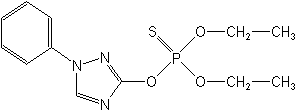|
Common Name: |
Triazophos
|
|
Chemical Name: |
O,O-diethyl O-1-phenyl-1H-1,2,4-triazol-3-yl
phosphorothioate
|
|
CAS No.: |
24017-47-8
|
|
Structure: |

|
|
Molecular Formula: |
C12H16N3O3PS
|
|
Molecular Weight: |
313.34
|
|
Physical Chemistry: |
Triazophos is slight
brown liquid; Melting point 0~5°C; Vapour pressure, 0.387Pa at 30°C.
Solubility, 39mg/L in water at 23°C; Readily soluble in most organic
solvents, e.g. in ethanol and toluene 30g/ml; in n-hexane 0.7g/ml;
in acetone 0.1g/ml; in dichloromethane less than 0.1g/ml; in ethyl
acetone 230.1g/ml at 20°C. Stable to light, hydrolyzed by aqueous
acids and alkalis; decomposed at 200°C
|
|
Toxicity: |
Acute oral LD50 for rats, 82mg/kg; acute dermal LD50 for rats,
1100mg/kg; LD50 for dogs, 320mg/kg. Some what degree of
cholinesterase inhibition occurred after feeding dogs at 100mg/kg
for 3 months; non-effect level for rats, 1mg/kg; LC100(48 hours) for
crucian (Carassius auratus), 8.4mg/l; 1mg/l for carp (Cyprinus
carpio). Toxic to bees and fish.
|
|
Application: |
A broad spectrum insecticide and acaricide
with some nematicidal properties. It controls aphididae
in cereals at 320-600 g AI (20% EC)/ha, in fruit at 75-125 g/100l.
When incorporated at 1-2 kg AI (20% EC)/ha in the soil prior to
planting, it controls Agrotis spp. and other cutworms. It can
penetrate plant tissue, but has no systemic activity.
|
|
Technical Purity: |
85%Tech
|
|
Formulation Type: |
40%EC
|
|



